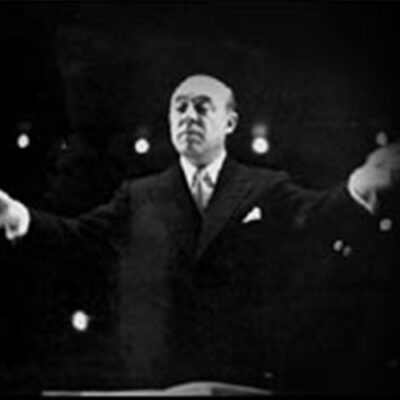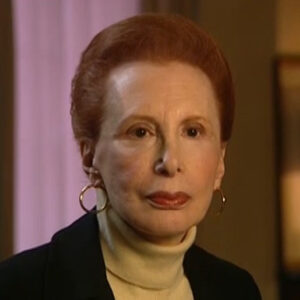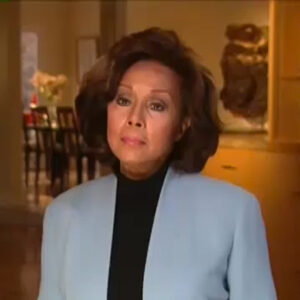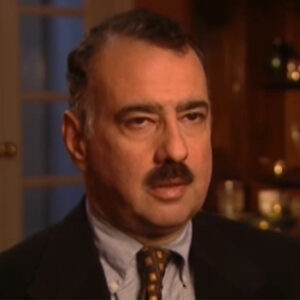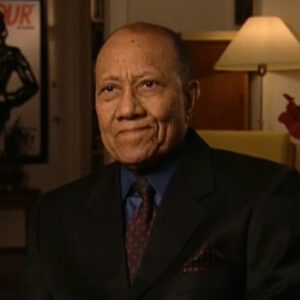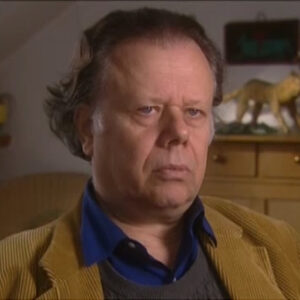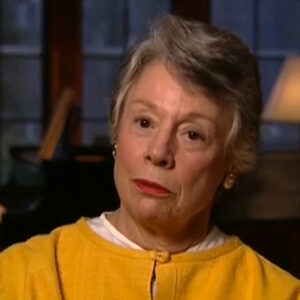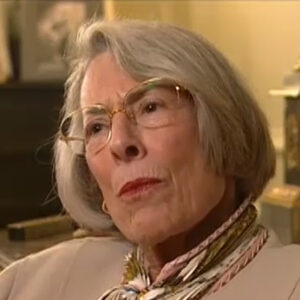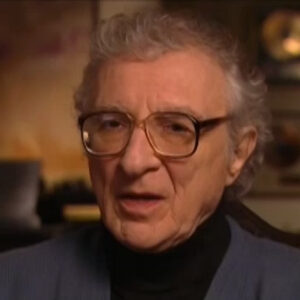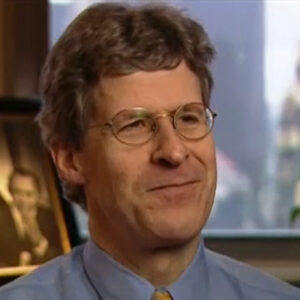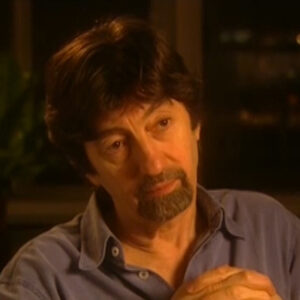Speaker 1 I suppose I began to hear Richard Rodgers as Richard Rodgers in 1955, when I was still nine years old and the King and I was released the movie of the King and I in that more than any work I can think of completely changed my life. I had up until that point been a puppeteer and a pianist. And when I saw the king and I was so overwhelmed by the entire experience, the wide screen, the exoticism of it, the music, the acting that I, I actually didn’t know what to do. And the only thing I could do was produce it myself in the backyard, which is what I did. And and I wrote the script sort of a memory and typed it up. And I knew that none of us could sing it. My friends couldn’t be our voices hadn’t even broken yet. And and so we got the soundtrack album and we made a tape of the entire show with all the text and we learned to lip sync. And when the songs came, we were Marni Nixon and Yul Brynner, et cetera. And my friend at the time, Judy Lieberman, was, and I needless to say, was the king and designed the scenery. And we put on a performance of the King and I in my backyard in East Meadow in Long Island. And it was so successful that we had to do it again for the grandparents for the next week. And that was the beginning of my relationship with Richard Rodgers.
Speaker 2 And you shaved your head and paid a royalty, the Rodgers and Hammerstein organization.
Speaker 1 You know, the other thing about my first production of The King and I was there two things. The neighbors who hadn’t yet seen the movie, when they saw the movie, they wondered why Yul Brynner was imitating me. So I but I didn’t dare shave my head. So I had a cut up part of one of my mother’s stockings and put it on my head. And when I got to record the king and I was Julie and Ben, many years later,
Speaker 2 I asked you to start that again and use their full names. Yeah.
Speaker 1 And when I got to record the King and I with Julie Andrews and Ben Kingsley, my wife got to say to me, well, at least you got to do the king and I again. In this time, he didn’t have to put one of your mother’s stockings on your head.
Speaker 2 And I understand as a child, that’s not the last thing you did.
Speaker 1 After producing the King and I in my backyard, I was lucky enough to see a revival of Carousel at the New York City Center with Howard Keel, Barbara Cook, Maury Powers, who was the first medium in John Carlos Menotti’s Opera, the medium Russell Kneipe, Pat Stanly, Victor Moore as the star keeper. I mean, it was the most amazing cast and I think about it now. And in those days at City Center, they would replicate the original production. So although Carrousel came out the year I was born, of course I never saw it, but I had an opportunity to see the original production years later, and I remember it as if it was yesterday. And Julius Rudel, the longtime music director of the New York City Opera, was the conductor of that over the years. Then I was hooked and I managed to go to the first, you know, the world, the first production of of let’s just take a moment, because I just went out in my head. Florida, I’m so OK over the years, just about. Yes.
Speaker 2 I want to stick to tell me about performing it and being there for that revival. Oh, well, I’m feeling about it. When that music was like
Speaker 1 when when I was that point eleven years old and seeing a full production of Carousel with that cast and hearing that music, it was another overwhelming experience because having seen the movie of The King and I the year before and now seeing Carousel, which was then followed by the movie of Carousel, which came out around that same time, it kind of really locked into my head the amazing impact of of music from Richard Rodgers, which today, you know, I think it is one of my great joys is that when I conduct Richard Rodgers, I think I’m happiest because I’m absolutely back to the beginning of my musical life. It’s I was really pleased to have gotten to meet Mr. Rogers a few times and to actually be able to tell him that and thank him.
Speaker 2 Tell us your times, you man. And what did you talk about?
Speaker 1 I met Richard Rodgers twice. I met him in New Haven when I was teaching at Yale. And in New Haven, of course, was where the Shubert Theatre is and was. And that was the place where every show we’ve ever heard have had its world premiere. And at the end of the era of the New Haven tryout was one of Roger’s last shows, two by two with Danny Kaye. And at the time of its world premiere, Rodgers agreed to appear at one of the residential colleges at Yale and meet the students. And I remember that because the room was completely packed with kids, undergraduates asking questions. And I managed to ask one question that afternoon, which was which which I think is still is the most fundamental and fascinating question you could ever ask Richard Rodgers, which would be how is it that with Mr Hart, you wrote the music first and with Mr Hammerstein you wrote the music after you got the lyrics? I mean, a completely different way of dealing with the fundamental collaboration of telling a story with song. And I think I must have asked the question. It must have been the 100000 millionth time he’d answered that question. And so he kind of said something like, well, you know, Larry wanted to do it that way and Oscar wanted to do it that way. So that was the end of the mystery. There was no mystery. It was a very kind of meat and potatoes answer. But the next time I got to meet him was in 1978. Mr Rogers had given, I think, 20000 dollars to NYU, to the Tisch School to create a school for music theatre. This was a school to be not to teach kids how to sing and dance, but to actually write shows. And I was hired by the dean of the music school, Robert Oppenheimer, to to interview every every leader of the music theatre to kind of get their advice as to how to create a school for young people to learn how to write shows. So the first person I went to interview was Mister Rogers, and he had given the seed money to start the whole thing. And I went to his office and I can remember it actually as if it were yesterday because I’d seen Rogers on television on The Ed Sullivan Show. I mean, I can I can I can hear his voice. I mean, as a kid, I was so fascinated with him. And and he was on television. He was one of those composers who was available to us. I mean, I don’t remember Irving Berlin, for example. And and of course, Gershwin was dead by then. And but so Rodgers was really one of those people you saw in American television. We knew him. And and there he was, of course. And I you know, he was wearing grey trousers. He had a white shirt on black suspenders and a black shirt and a black tie. I mean, so he looked like an image from some other. Other century, you know, he was very granpa, like, I mean, like my grandpa, not my son’s grandpa, you really and I you know, I stood up in the waiting room and he came to shake my hand and he had had his his operation on his throat. So, of course, he couldn’t speak very well. But I remember the collar of my my jacket was up and he came over to me and shook my hand. And then like a good grandpa, he fixed my collar and then had me go into his office. And it was so sweet, you know, to meet really actually meet this man who had so inspired me. And for him to actually fix my collar was really kind of dear. Anyway, we sat and we talked, and he actually hadn’t thought about much about how one could create a school or how to teach kids to write shows. So instead, we found ourselves kind of talking about stuff. And we talked about his grandson, Adam Gadahn, who was so proud of because Adam at this time was singing the solo boy soprano parts at City Opera where I was conducting. So I had met Adam when I was conducting Mephistopheles at City Opera. And and a lot of them, in fact, Adam came up to me during one of the intervals, and then Adam must have been nine years old and asked me about what kind of batons I use. He was really interested in because he was watching me while he was on the stage and someone said, you know, that’s Richard Rodgers grandson. And I went, Oh, that’s really cool. You know, that’s really. And so I talked about Adam for a while. And then we kind of talked about what made him a composer, how he was, how he was trained, I thought might inform me as to how maybe to advise NYU in training composers. And that was really interesting because I didn’t know that story, at least the story that he told me that he went to Columbia for two years because he said he wanted to write the variety show. That’s why he went. And after two years, he said Columbia couldn’t give him anymore. So he went to music and art, which became Juilliard and at Juilliard at what was was to become Juilliard. He studied with a teacher named Krehbiel and he said, I guess you wouldn’t have known him because Krehbiel would have been dead before I was born. But but he said he was a tall man, really impressive. And he would cry when he talk about Beethoven, when he would teach us about Beethoven, he said in every Friday we’d go to Carnegie Hall and stand in the back and cry, listening to Beethoven, he said. And there was another teacher named, he thought, Anderson, who taught him about bass progressions. Now, if you’re not a musician, it’s simple enough to talk about. It’s how the bass line moves in the song. I mean, everybody who listens to songs listens to the tune, which is basically on the top usually of the harmony. But what’s supporting that is the bass line in Rogers had never thought much about how the bass could move and therefore change the whole color and the whole impact of a song which basically sits on top of that bass line. So that I thought was really interesting. Then he told me about his dad, who was a doctor, and he said, you know, we weren’t rich, but we had enough money. And my parents got behind me and he said and pushed and he put that, you know, pushed me. And he got to meet the wife of the man who wrote the song Nola. He told me. And it was this woman who said to him that there’s this guy named Jerome Kern, whom he should learn about. And it was in fact, he said, Jerome Kern and the inspiration of Jerome Kern that made him a songwriter, that what Jerome Kern did with the song was so awesome to him that he decided he would not write symphonies and operas, but he’d write songs. Was that good enough for. Is that a good riff
Speaker 2 when there was one little glitch in that going to Columbia, you want to do the varsity shows? Yeah. So maybe I’ll ask you just tell
Speaker 1 us, what did I say was the right of passage? I knew it was that they
Speaker 2 were variety shows. Right. It’s David Oppenheim.
Speaker 1 Oh, did I say Robert Robert? Yeah. He’s the one who was supposed to be the atomic bomb and he
Speaker 2 was the head of David Oppenheimer’s.
Speaker 1 David. Yeah, it was David. Yeah, but maybe so. So how would you like to deal with those two issues?
Speaker 2 Let me ask you the question again. If you could just give me a very short answer of that, OK?
Speaker 1 Because you because editing in and out of that would be almost impossible.
Speaker 2 Tell me what Roger said to you and use his name again about why he went to college.
Speaker 1 So we decided it would be best to talk about how he became a composer, because I figured, well, I’ll do this again. So that, in fact, you want to come in on this story and say, when I met him, maybe that would even help you. When I met Rodgers in 1978, I. I was there to talk to him about how to train composers and lyricists to write shows because he had given the seed money for the Tisch School to be created. And and he he told me that he originally had gone to Columbia because he wanted to write the varsity shows, which he did for two years. And after two years, he realized that that was all Columbia could give him. So he went to music and art, which became the name became named Juilliard Later. And at Juilliard, he studied with a very famous teacher by the name of Krehbiel, and he asked me if I’d ever met him. And of course, that would have been impossible. He realized that that that would have been impossible. But he said he was a very impressive man with a white beard and he used to cry whenever he would talk about Beethoven, he said, and every Friday we’d go to Carnegie Hall and stand in the back and listen to Beethoven and cry. And it was another teacher by the name of Anderson, who he thought his name was Anderson, who taught him about the power of bass progressions. Now, I don’t know whether people know what I mean about that, but in any case, a song is usually on the top of what people hear. It’s what people listen to. It’s most arrangement’s or whatever it is, it’s what people listen to. But under that is a baseline that notes on the bass and the way those notes move in. Contrary, motion to the melody on the top or in parallel or hold can change the whole color and the impact of a song. And that’s the thing that completely astonished Rogers because he’d actually never thought about that, because he’d written songs, of course, up until that point. And it was later he said that he met the widow of the composer who wrote NOLA very famous song, and she told him about this new guy named Jerome Kern, who Rogers should actually get to know. And actually, Rogers only met Jerome Kern, I believe, once or twice. He said to me that it was Mrs. Kern who put a wall between Jerome Kern and the rest of the world. So he never got close to Jerome Kern. But he did say that it was what Jerome Kern could do with a song that made him want to be a songwriter. He decided that he was it was not for him to write symphonies or operas, but because of what Jerome Kern had done, he wanted to be a songwriter
Speaker 2 of quite a few musicians, when I should say you’re not playing. But if you want to hum a few bars or bars or recite some lyrics or anything like that, to give us an example, feel free to. Hmm.
Speaker 1 If I did that
Speaker 2 know, it’s not like you hear the reaction of your band better the other way. I want to talk to the bass line because a number of musicians have said that that actually is what is. So Richard Rodgers about Richard Rodgers. And can I ask you to comment on that part of it, whether that, well, even astounds you more or.
Speaker 1 You can see the problem is that if I talk about too much more people are going, I still just wonder what the hell we’re talking about unless we actually do it.
Speaker 2 What still astonishes you about Richard Rodgers music?
Speaker 1 I suppose what astonishes me most about Richard Rodgers music is his innate way of being immediately user-friendly. I mean, right from the moment you hear a tune, he’s invited you in. And yet once you’re in this tune, he does these very subtle things that makes the tune unique. He does something that elevates it beyond something that would be so simple that you don’t even think anybody composed it. So there’s this perfect balance between friendliness and comfort and astonishment, which is fundamentally what we need in a popular song. For me, it still astonishes me at how much his music changes between the the heart time, the Rodgers and Hart time in the Rodgers and Hammerstein time. Because even if you listen to say I remember every one of the albums I grew up with was something called the Columbia Album of Richard Rodgers with with Andre Kostelanetz. It was two LPs. And yet and on that album, there were waltzes from the Rodgers and Hart period and some of them from Hammerstein and period and back and forth. But still, there’s a kind of change that is so amazing and hard to describe between the two lyricists and how Rodgers responded to the kinds of shows he was writing and the topics somehow with Hart, since almost every one of the Rodgers and Hart shows takes place in a contemporary time. These are not the exotic shows except for Connecticut Yankee. I mean, there’s some example, but Connecticut Yankees joke is that it actually takes place right now. It’s just that everyone is saying forsooth. But I mean, so there’s that, you know, same thing with boys from Syracuse. But I mean, they are so completely superficially exotic that they send up the whole idea of it, because, in fact, what’s so funny is that everybody is just like they are now. No one attempts to be actually really ethnically correct or even from the point of view of of the time. So even though we’re in the court of King Arthur, we are absolutely in, you know, the period, whether it’s the first or second version of Connecticut Yankee. However, with Rodgers and Hammerstein, there’s a completely different kind of Richard Rodgers. And that, to me is completely amazing. There’s a kind of breadth of of lyricism that comes out of the Rodgers and Hammerstein period that isn’t quite there, though, in the Rodgers and Hart period. There’s a kind of there’s the brittle cynicism, but also this wistful burst, you know, prediction of the lyric, even though the lyric didn’t exist when he wrote the song. So you could almost say, I guess the Rodgers of Rodgers and Hart is pure Rodgers because he’s not actually responding to a lyric to to an image necessarily by by anybody, although they could have had a title before he wrote the song. Whereas with Rodgers and Hammerstein, he’s responding to the poetic vision of Oscar. And in that, to me, is still the most amazing aspect of this extraordinary composer who had two complete careers. Actually, you could argue three.
Speaker 2 You talked about the idiom of this of this exoticism. Can you tell us about. How the research Rogers did to bring us to Oklahoma to
Speaker 1 well, let me just ask you a question. Does anybody know that he actually did any research, do any research? Yeah, that’s what I’m going to say. I mean, he just wrote. Well, go
Speaker 2 ahead. All right. That’s very interesting to our audience.
Speaker 1 OK, so ask away or I’ll do it. You didn’t ask? Yeah.
Speaker 2 The only thing we know is that Oscar said in a book of American folk songs in nineteen forty three. He said he flipped through.
Speaker 1 Yeah. Yeah.
Speaker 2 Bookstand and just did his own.
Speaker 1 Well that’s what’s really awesome. We’ll start this. What’s really interesting about, say, the Rodgers and Hammerstein period is that all of those shows, with the exception of me and Juliet, I guess you could argue and pipe dream, but that’s exotic because of where it takes place. But me and Juliet is a perfect example, all take place in some exotic place, some time or place. So in a way, the Rodgers and Hammerstein shows become what we used to think of as operettas from the point of view of their place. I mean, the student prince, you know, this is the kind of things those operettas from moon over Hawaii, from, you know, Germany, those kinds of things. And so suddenly with Rodgers and Hammerstein, you’re into the land of operetta. And yet he doesn’t, except on the most superficial level. Right? Ethnic music. I do remember hearing Mioshi Rumaki talking about 100 million miracles before the world premiere of Flower Drum Song. And she, as an Asian woman, said that although the song wasn’t really Asian, it seemed to feel like a song from her ethnicity. And I remember that song made us all sit up and and listen. It was a contact thought. They thought to be good. They’re good. He was on it. Oh, what does that you know, of course, I was 12 at the time, so it was a really big deal to hear that. But ultimately, when you think of the king and I, except for a few gong blasts from Robert Russell Bennett and and maybe is a puzzlement, you know, just setting that up. The songs we know from that are just wonderful songs that don’t necessarily take place in Siam or any other place. I think it’s really significant if we look at that period where America is finding its voice in the so-called classical music repertory where where Aaron Copeland in the late 30s and middle 40s and just at the end of the war, writes his three American ballets. So, you know, you have Billy the Kid and you have Appalachian Spring and you have rodeo or rodeo. And and to start with, Aaron Copeland, a New Yorker like Richard Rodgers had to deal with, what does a New Yorker in this case, a guy from Brooklyn, know about Billy the Kid? So Lincoln Kirstyn gives him a book of cowboy songs and Aaron Copeland fundamentally uses them. I mean, he doesn’t write his own melodies for that. That’s cowboy music. Richard Rodgers for Oklahoma, you know, gets a book of folk songs, looks at them and throws it out and writes music, just writes. And it’s it’s amazing. I mean, people unfairly don’t give him credit for what he actually achieved there, whereas everybody admires Aaron Copland enormously for what he did. Now, it’s true. Aaron Copeland, you know, achieved an enormous thing with Billy the Kid. He created a serious popular sound for America in the concert hall, in the ballet, in ballet theaters. And to this day, that’s what people quote when in Europe, when they think of the American sound, the pre West Side Story Sound of America, it’s Aaron Copland’s kind of I wouldn’t say composition, but it’s his arrangement. It’s a way he sets a cowboy song to make it seem like we’re there. But with Rodgers, who is maybe less known in Europe as Richard Rodgers, he’s not given credit for, of course, what he did because, oh, what a beautiful morning. It is an amazing achievement to start a show like that and to find that waltz that that spreads out over over the keyboard or wherever it is, the range. And when you hear a country singer do it, because we did a performance of Oklahoma using the film orchestrations, I’ve tried to restore the film orchestrations of Rodgers and Hammerstein because I believe they are as important as the Broadway orchestrations. And we had country singers sing it. And it’s not easy because really, fundamentally, Roger’s almost always wrote for really trained voices in Rodgers and Hammerstein, whereas in Rodgers and Hart they were more the Belters and the speakers.
Speaker 2 I didn’t know that, um,
Speaker 1 well, you try and do oh, what a beautiful morning, you see, you can’t hold it when you’re singing like that. So you really have to be a singer who can hold a note on everybody.
Speaker 2 Um. Tell me about Roger’s composing dance. Did he have trouble with that or was it something he loved and he just turned it over to somebody else?
Speaker 1 I think Roger’s must have always wanted to write larger forms because he did study composition like a regular person. And one of the things he said to me about studying at music and art in New York, music and art in New York, which became Juilliard, was that there was no snobbery against a person who wanted to write a song. They didn’t treat you badly because you wanted to be a songwriter as opposed to a symphony writer at the same time since he had that experience going to Carnegie Hall. And in fact, he talked to me and he was so proud of the Rodgers and Hammerstein Library Sound Library at Lincoln Center. And he used us as an example, said if a student wants to listen to the Meistersinger overture, he can dial up whichever one he wants. So he used Wagner as his example. To me, it was not. And I think that’s important for people to understand that, that certain popular composers were completely trained musicians and they actually and most jazz musicians that everybody knew everybody else’s music. And it’s a complete false image that people in certain categories didn’t know people’s music and other categories anyway. I think Roger’s way of writing larger forms was to be able to write ballets in his shows. Mind you, if he was working with Mr Abbott or with whoever Josh Logan or whatever, when the the libretto or the story required a solution, a dramatic solution, which would be a ballet, a dream ballet in some cases, or maybe a performance within the show, it was a good excuse to write extended music. I know that at the time of the Carousel Waltz, I mean, of course I was too young to know this, but I read about it later. People actually accused Rodgers of not writing the Carousel Waltz. This is a normal thing to say about any songwriter or popular composer who attempts larger forms. Recently we heard that about Paul McCartney and Standing Stone. I read a really nasty piece about George Gershwin at the time of an American in Paris, which actually implied that he actually didn’t write it himself, but someone arranged it so it would be normal. So one heard that either Aaron Copland or who knows what else somebody else had written. The carousel was, for the most part, the early ballets.
Speaker 2 They criticized that. Why would that be?
Speaker 1 It was assumed that a pop songwriter or a songwriter would not have the technique to write a larger form. And because Broadway is a relatively honest place and and Hollywood is an even more honest place, which in which and by that I mean people are given credit for helping. So orchestrators and arrangers get their name plastered all over the screen or in the program book now, you know, musical direction, musical supervision, additional dance arrangements, orchestration, spy, et cetera. People therefore assume that no single person is actually in charge. There’s this kind of 19th century fantasy that the great works of art are created by a single hero person. Mr. Beethoven in his room writes every note, and therefore that makes it better than if a group of people get together. Well, the theater has always been a collaborative art form, and so it should come as no surprise that a lot of people get into making decisions. In any case, Richard Rodgers wrote Slaughter on Tenth Avenue. We have that manuscript for sure. He wrote The Princess and Obeah Ballet. He did at certain times in the Rodgers and Hammerstein period. The ballets, the dream ballets are not completely written by him or they might have been arranged by somebody else who works with the choreographer. The reality is against the mill said to me in those days there was a separate company. The dancers were separate from the singers. By the time we had produced On Your Toes in the 1980s, we had the kind of talent on Broadway where a person in the chorus could do the tapping, could do the singing and could do the ballets, which was not the case with On Your Toes. In 1936, they had a separate ballet company to do the ballet scenes. And so you would have in a separate theatre in that case, George Balanchine doing slaughter on Tenth Avenue while the other company was doing, you know, on your toes, which was a different group of people in the time you get to Rodgers and Hammerstein. Therefore, Agnes would be working in another theatre during the day, a theatre that had a show on at night. And you rehearsed in the other theatre because the scenery wasn’t so complicated then. And and of course, you had a pianist and Agnes’s pianist from Carousel On Not for Oklahoma was a woman called Trudy Richman. And her real name, of course, would be to do a little man. And Trudy Richman was a Jewish German composer, pianist who Agnes had encountered in Amsterdam. Now, this is an amazing story. Trudy Reitman was escaping Hitler with her sister, the two. Them were pianists, and Agnes Dumbell heard Trudy Redman playing a piano concerto written by herself in Amsterdam as the Nazis were approaching Holland, and it was Agnes who brought Trudy Whitman back to New York as her pianist. And as a result, Agnes helped save Trudy Whitman’s life. Trudy Whitman then went on to be the arranger, the person who put the melodies of Rodgers together with the exact counts for the dance steps for Agnes to mill for basically the rest of Agnes’s life. So that means that all of the Rodgers and Hammerstein shows that have been ballets that were originally choreographed by Agnes to Mitchell are arranged. The music is arranged by this woman, Trudy Richman, who is who escape as a refugee of of Germany. And and of course, Trudy Whitman also did the dream ballets or the ballets for Lerner and Lowe and for so many. And and just parenthetically speaking, Agnes said to me, the only composer, the only composer for whom who then who wrote his own ballet in that period was caught fire because when they were working on one touch of Venus, Trudy Whitman was playing for Agnes. And then the ballet would be created. And then Viall took all the counts and dance steps and wrote music over the music that that Trudy Whitman had written. So he actually did write his own ballets. But Roger’s, of course, when you say didn’t write, all the material comes from Roger’s music, from his melodies. And then, of course, Rodgers is there at all the rehearsals. So, of course, he approves of it. If he doesn’t like it, it gets changed. And so, in a sense, yes, it’s a collaborative process, but it would be wrong to say that the composer did not have the final say. And Mr. Rogers was actually quite notorious for being quite difficult about demanding the highest level of concentration and commitment from all the people who worked for him, whether it was an arranger or whether was an orchestrator. I know from knowing Hans Bialik, Hans Bialik, who orchestrated many of Rodgers and Hart, shows Hans was a refugee from World War One. He had sung under Gustav Mahler as a 10 year old in Vienna, and when he was 14, he was bayoneted by a Russian soldier through the hand and so was a prisoner of war in World War One, lived through the Great Revolution in Russia, escaped through South America, became a copyist for Victor Herbert and sat in the chair right behind Robert Russell Bennett, and then went on to become the orchestrator for Rodgers and Hart and for George Gershwin and for Cole Porter. So, I mean, that already is an amazing story because we. But but Hans said to me when he was 87 years old, how difficult Rodgers was. There were great moments like when Hans orchestrated the pantomime and there’s a small hotel. Rodgers apparently like the sound of the bass oboe, which is a very unusual instrument. And so there’s a place in in this pantomime with detoured or eat or don’t eat or adored. It’s played on the bass oboe. And Hans tells the story, told a story of hearing it the orchestration. For the first time, Ray Boulger looked over the pit and turned to Hans with tears in his eyes of gratitude for what Hans had done. But actually, because Rodgers was so difficult to work for, it was really because of Rodgers that that that Hans left composing, orchestrating for for the Broadway stage and went on to arranging for Balanchine for the ballet and worked in radio because of this, the really difficult part of Roger’s personality, David Rax and the Hollywood composer who wrote Laura and so many other film scores was Haynes’s assistant on On Your Toes. And he he confirmed this aspect of Roger’s personality that made him so difficult to work with. So it would be wrong to say that any of the any note in any ballet ever from Annie Rodgers and Hammerstein and Rodgers and Hart Show did not have the direct approval of Richard Rodgers.
Speaker 2 Talk about a little bit more about this being difficult. Is it wrong to be a perfectionist? Is it wrong to be a control freak? Is it wrong if you or some people say genius to make sure everything is as easy as psychotic? Is he, you know, talk about that for a minute.
Speaker 1 I think the issue of Roger’s being difficult always comes as a surprise to people because the music is so genial. And and so you just assume this Mary, this Mary guy wrote it. You make the intentional fallacy in this whole thing where, oh, he must have been in a good mood when he wrote that happy music, or he must have been really sad when he wrote that sad music, as if you don’t separate the two things. And quite clearly, Rodgers was a perfectionist, but apparently he had ways of demanding perfection. That were so demeaning to people that they absolutely couldn’t work for him. My experience with him and I didn’t work with him, of course, was wonderful because he was so wonderfully nice to me. And I’m really glad that that’s how I got to know him. I think the stories about his the difficulty in his personality about later years when he sometimes drank more than he needed to is is what I’ve heard and therefore got even more angry or mean. These stories are sad, perhaps, and not really to the point. I mean, if you didn’t want to work with them, then you stopped and then some other person came in and worked with him because actually he was such a genius that it’s hardly it’s hardly anything when you think of some other great composers of the past and actually the way they behaved. But what is interesting about Rogers is that he demanded fidelity to his score from his singers. You see, the issue of jazz arrangements of Rodgers is maybe relevant to us today. But in Rodgers time, he didn’t want anybody changing his bass notes and he didn’t want anybody messing with his rhythms. He absolutely was very strict with what was allowed and what was was not allowed. He wrote what he wanted and he wanted you to do that. The interpretation where interpretation started and when it became something that distorted his vision was at a very, very low threshold. He did not allow the way, you know, Gershwin immediately was taken up by jazz people and only perhaps in Pal Joey, when you have a kind of a jazzy score, could you even think about doing that. I mean, when you get into, you know, the saxophones in in me and Juliette, you’re almost embarrassed because or they call it Grant Avenue, San Francisco, it’s going to Proteau Rock and Roll. You just don’t want to hear that. Even when Rogers tried to get down, as it were, and get get contemporary, it just was awful. It just didn’t work. When he was writing music, that was kind of internal music that could have been written any time from 1910 maybe, or even 1900, right through to 1970, any time. And then he was eternal. And then he was really tapping into a kind of a stream, a universal stream that that for which then that line then he was absolutely in perfection. He was a perfect conduit of that melodic tradition. There’s a there’s a great story about Rogers. Absolutely. His his fidelity to himself. He did not want people to change his music. Peggy Lee had recorded Love Her, and it was number one on the hit parade. And it was it was done in this kind of Latin kind of way, the way the way Peggy Lee did everything. And she was in a room and Rodgers was there and she decided to go up to him and say, Mr. Rogers, isn’t it wonderful that we have this number one hit of love her? And he looked at her and said, Miss Lee, it’s a waltz. And that was that, and I mean, and completely it says a lot about him, we assume we’d never do that, say, to Beethoven and we never do that to Mozart S.. So we assume that because Rogers was in the kind of popular music world, that it’s free it’s free license to do anything you want to do with this stuff. And I think it’s really important to know that he actually didn’t like it. And I know that when we were recording The King and I with Julie Andrews, her music director at one one or two times, said, wouldn’t this be better with this note on the bottom? And I said, believe me, the one thing we’re never going to change is a bass note because of all the things that Rodgers cared about. It was his bass notes. Don’t mess with them.
Speaker 2 Great. Oh, great.
Speaker 1 So we should do the orchestration thing, because I do. OK, let’s all this up.
Speaker 2 Oh, just you
Speaker 1 OK, whatever you want sort of it. Good, just do it. Ask me your in Mozart
Speaker 2 and Beethoven in the same breath as
Speaker 1 I did.
Speaker 2 And how are they can they be talked about together? Is Rogers as great as all these greats and mention them by name if you think.
Speaker 1 One of the difficulties we have when we talk about the 20th century is ascertaining who are the great composers and whether we have a single criterion by which we can judge them. We’ve lived in a 20th century where all music is broken into two categories, popular and serious. And, you know, I’ve talked about this for so much of the time now for the past 10 years that, you know, it’s boring to hear us hear me say this, but popular is not the opposite of serious in any language I know. And it’s perfectly possible to be really serious and be really popular. And it’s also it’s also possible to be really frivolous, you know, and to be completely unpopular. And it goes, you know, it’s a little thing like a little square there. So, for example, Carrousel is unbelievably popular and profoundly serious. It’s much more serious than, say, deflater mouse. And and one of the odd things is that if a classical music station plays the castle walls, they’ll get phone calls about why are you playing this music? But if they play the overture to Deflater Mouse, no one complains. So I always use this as a very good example of the kind of problem that we have in judging music like Richard Rodgers. Is he Mozart? Is he a Beethoven? We have to face the reality. As uncomfortable as that makes certain people that Richard Rodgers was one of the geniuses of the 20th century period. If you look at Schubert, who was fundamentally a songwriter and he wasn’t taken seriously in his own day, you know, when Schubert died, which was the year after Beethoven, nobody even went to his funeral. No one could him they just his friends had to find money so they could bury him because he was known as a songwriter, which was kind of the lowest form of musician in Vienna in 1828. And we kind of face that still today with someone like Richard Rodgers or Jerome Kern. These men were our greatest composers. They are our great American composers. And if they’re the greatest American composers, then they are the greatest composers, period. Because America, for 75 years of that hundred years called the 20th century, was the fundamental source of most music that we all here play and sing in the world today.
Speaker 2 Great. Let’s cut for a minute. Do a little. Yeah, hopefully. Hopefully she’ll know not to come in when the doors close. We’re rolling. We’re, um. What’s so special about orchestrators, composer,
Speaker 1 one of the aspects of Broadway shows that, well, some people know about, because if you care about Broadway shows, you actually care about this, this. But on the other hand, there are a lot of people in the general public who may not think about is the question of orchestration and what even does that mean in that means that when someone’s on that stage singing who’s what’s in the pit, what’s accompanying, oh, what a beautiful morning, what’s actually playing the harmonies and doubling the tune? How does that sound? And that’s that could be anything in the pit. That could be 35 people with violins, violas, cellos, basses, an oboe, a triangle. It could be, you know, four saxophones and a synthesizer. I mean, nowadays, it’s a great it’s you never know what you’re going to hear in a Broadway pit. Rogers had very specific orchestrators who who gave us the color, the actual color of of of Broadway in the Rodgers and Hart time. It was mostly a man called Hans Bialik, the Viennese orchestrator. And and and Hans explained to me how during the Rodgers and Hart period, how it moved from being violins, violas, cellos and bases to suddenly adding saxophones later on around the time of pal Joey. So the violas disappeared and were replaced by saxophones, giving it an even more contemporary sound, the sound of of World War to America, the period of 41, 42, 43 this period, the big band coming in. And that’s part of how Rogers stayed contemporary, the very sound of what was playing in the pit while someone was singing. And and it also changed. But interestingly, how it changed, because in the early days of Rodgers and Hart, there was always the doubling of the melody in a violin somewhere. So, for example, if if Vivienne Segal was singing I’m Wild Again, Beguiled again, the violence are going da da da da da da da. And when the revival happened, the famous revival in the 50s, she said, I just don’t want that to double me anymore, because by doubling the melody, it meant you were linked rhythmically to sound exactly the exact rhythm. So you couldn’t say I’m wild again, because before you’re waiting for the word wild, the violins already played that note. And dislike is a constant back and forth, you know, so. So Roger’s life, of course, goes up to the Rodgers and Hart time with horns. And then after it we basically have the Robert Russell Bennett period, which is a very symphonic sound. If you think about Oklahoma, the only thing that makes it sound like it’s a cowboy is that
Speaker 2 he didn’t wake.
Speaker 1 We’ll wait till that stops. I just want to
Speaker 2 close the door quickly, settle. Stop where you are. Go ahead.
Speaker 1 You started getting wet and waiting for it to stop. One of the things that makes the Rodgers and Hammerstein period so different is that it’s almost all Robert Russell Bennett, with the exception of Don Walker, occasionally like with Carousel, which is a big exception. But those are very symphonic orchestrations and so is Carrousel. In fact, with Carrousel, Rodgers had a 45 piece orchestra in which he had to take out two rows of the theater in order to fit in such a big orchestra. Now, one of the great things about Rodgers and Hammerstein for the theater is that these orchestrations are perfect. They’re perfect orchestrations. One tends not to hear them again today because they cost too much money. So when you see a revival, a current new production, as it were, a revival of a show, you almost never hear the show as it sounded originally, which is a real pity because the orchestras were so big. But even more interesting and this is really interesting for me, is that Rodgers and Hammerstein took such care about these properties. Not only did they create their own publishing firm so that they controlled their own music, which is a great thing, but they helped produce or actually produced the film versions of these shows. Now, again, the general public doesn’t understand this. When when George Gershwin, one of the George Gershwin shows, got turned into an MGM musical, he didn’t control it necessarily. So if you see a strike up the band by MGM, it has very little to do with the show. Strike up the band on Broadway if Cole Porter sold his rights to a show. Kiss me, Kate. Let’s say they rewrote it completely. Leonard Bernstein sold the rights to on the town and half his score was thrown out. Now, Rodgers and Hammerstein were there to produce Oklahoma in Tardio. So now for a movie, you don’t have the problem of having a pit with the can only fit 34 instruments in. And the only limitation is the limitation is the budget for the film. So suddenly you have orchestrations, you have now a 90 piece orchestra to accompany. Oh, what a beautiful morning. You have something for the King and I where you can have 16 percussionists hitting gamma lawn’s and gongs. And infrequently it was Robert Russell Bennett once again who was brought to Hollywood to do what he did for Broadway. But amplify it. Or it was someone like Eddie Powell who was one of the great orchestrators of Hollywood because 20th Century Fox, which is where all the all of the musical films of Rodgers and Hammerstein came from, had some of the greatest orchestrators, the man who could imagine color and sound and this huge orchestra. That means that each of the Rodgers and Hammerstein shows that was turned into a movie exists in two musical versions, both of which were approved by the composer, one for a chamber orchestra, the version seen on Broadway and one for a full symphony orchestra, which was produced for Hollywood. And they’re both equally valid. And that’s one of the reasons why I spend so much time restoring the film orchestrations, because when these songs are played by symphony orchestras, they can now be played the way Rogers approved them. And usually that was the last time he looked at one of these shows and there was a show like Oklahoma from 1943. He got to look at again in 1954 or 55. He got to look at the king. And I am 51 again in 55, 56. By the time he did The Sound of Music again, he got to look at it and say, this would be nice with this, etc.. The other interesting thing I shouldn’t say that one of the compositional elements of the film versions of the Rodgers and Hammerstein shows is that Rodgers approved the idea of using the melodies to underscore dialogue. Now, this is a completely different way of of presenting a play in some of Rodgers and Hammerstein shows. There’s underscoring, while people are talking, that certainly takes place in the famous bench scene from Carousel. But in a movie, you can have the full orchestra playing under the dialogue all the way through a scene. And you never have the problem of one thing being too loud. So, for example, great scenes in The King and I, which break your heart because there are memories of songs from the past, you know, something wonderful or we kiss in a shadow completely break your heart. Now, Roger’s music is so potentially dramatic as well as actually dramatic that it actually lends itself to being dealt with as if this were an opera. The only thing different is that instead of people singing these long scenes, they’re speaking and this full symphony orchestra is telling you this heartbreaking story. And and when we recorded The King and I with Julie Andrews and Ben Kingsley, I made sure that at least a third of that recording includes this underscoring, which is overwhelming, and a lesser composer could never have his music sustain that. Kind of dramatic tension, tell
Speaker 2 us, for those of us who don’t know what underscoring is just yet
Speaker 1 in the Rodgers and Hammerstein movies, instead of their just being songs and then dialogue between the songs and the and the dialogue while the dialogue is going on, an orchestra continues to play. That’s called underscoring. It is under the speaking. It allows for a kind of amplification of the emotion of development of the of the themes almost in a volunteering way, in a kind of almost Puccini Faulknerian way. If if if Rodgers were a lesser composer, it could it would seem just absurd. It would be ridiculous to take a dumb little tune and have the violins and violas and harps playing it while two people are talking instead because of the potential of Roger’s melodies. This is what you might call classical potential, the potential of developing them beyond a song form in these film versions. The music continues under talking in many of the most dramatic scenes, giving it a kind of emotionality that goes way beyond what it could have achieved in the theater. And that’s another reason why we made sure that in in the King and I recording that we made with Julie Andrews and Ben Kingsley that the underscoring some of that exists on that recording. To give you the idea of just how monumental the potential is of Richard Rodgers music.
Speaker 2 You said that that the orchestration is at one point the violas and three, four saxophones and you can have all kinds of different things. Is this OK? And that Rodgers approved that. What? I’m not sure I understand. Maybe you can make a little clearer for us is, was he telling the orchestrator, orchestrator, you know what, I think we should start using saxophones? Or is it is he just saying, here it is, go do what you want and I’ll approve it later?
Speaker 1 The relationship that Rodgers had with his orchestrators was various in the case of Bennett. Certainly Robert Russell Bennett knew what Rodgers would want. Rodgers occasionally, as far as I understand it, made specific demands of the orchestrators to do certain things. And of course, those orchestrations, when they were played, would be completely approved by him or thrown out by him. And Hans Bialik, who told me many stories of of playing the orchestration of playing them through for Rodgers at the time of the Rodgers and Hart shows, and how Rodgers was very, very particular about what he wanted. I mean, I don’t think it was like with Leonard Bernstein, who absolutely wrote his orchestrations with Sid and Irv, who were his principal orchestrators, who worked with him and Herschbach. These people were more or less following Lenny’s lead. Lenny sometimes actually wrote some of his own orchestrations. And I don’t see Rodgers is fundamentally thinking in orchestral terms. He was thinking in singing in song terms. And this is, of course, one of the issues of the his biggest score, which is victory at sea. I think the relationship between Robert Russell Bennett and Richard Rodgers for that almost came to the breaking point, as far as I can understand, because Rodgers was meant to write a 13 hours of music for this 26 part series of half hour shows. And according to Bennett, you know, Rodgers really actually only wrote, you know, I don’t know, three or four minutes of music. And the rest of it was was Robert Russell Bennett writing all of the music that took those tunes and developed them over over the the hours. I don’t know the truth of that, because I’ve never looked at the manuscripts of how much Rodgers wrote. The most important thing about victory at sea is that the parts we do remember are definitely the melodies that Richard Rodgers wrote. And Bennett, I think, very, very carefully. And of course, I wouldn’t even know what the contract was like. But I do remember the recording that Bennett’s name was as big as Richard Rodgers, though it was below it. But that was amazing to see. And orchestrators name the same size as the composer. Hans told me that, of course, for many years on Broadway, you never Hans Bialik told me for many years on Broadway, you never even knew who the orchestrator was. He said the first time he was ever mentioned was in the late 20s where he was listed between the shoes and the asparagus.

